HD520
back to Sennheiser
back to measurements
home
published: Sept-18-2022
NO SMOOTHING is applied to the shown plots. Most measurement sites have some smoothing applied which ‘irons flat’ sharp peaks and ‘wiggles’. I do not use smoothing because some info about sound quality is lost when plots are smoothed.
Aside from a small correction of the microphone itself also some correction in the lowest frequencies is applied to the plots to compensate for the perceived loss of bass when using headphones. This is described HERE in more detail.
A ‘horizontal‘ frequency response curve on the shown frequency response plots on this website thus indicates a perceived ‘flat’ tonal signature.
ALL measurements are made with a good SEAL on a flatbed measurement rig.
The shape of your head, bone structure, pad size, pad ‘softness, (compliance), hair or no hair and or wearing glasses may (drastically) change the frequency response of some headphones, so… your personal experience may differ substantially from these plots.
Frequency response (tonal balance) is the most sound-determining aspect of headphones. A horizontal line shows audible neutral response in the plots on this website. Deviations in different severities at different frequency bands have an effect on the sound character.
The bigger the deviation the stronger the effect.
Below an aid to help determining the sound character of headphones with relation to the frequency response.

Sennheiser HD 520
The Sennheiser HD 520 is an open over-ear headphone. When this headphone came out around (1985) it sold for around € 90.-. That is… converted from HFL to Euros and not including inflation. In 2022 this would be around € 250.- Around 1994 it was replaced by the HD 520-II which had blue cups so easy to tell these apart.
It was the cheapest option of the over-ear HD 520 ~ HD 530 ~ HD 540 reference ~ HD 560 family back in the late 80’s and replaced the HD 425 / HD 430.
The 3m long cable is connected via a predecessor of the familiar 2-pin Sennheiser plugs. This connector had 2 flat pins and could be inserted the wrong way around. This is exactly how the reviewed headphone reached me. One connector was in reverse polarity. The long cable indicates that this headphone is primarily intended for home/studio. The cable has a 6.3mm nickel plated TRS jack.
The cable is just slightly microphonic so in quiet passages and silences the cable rubbing against clothes is audible in the cups.
The headband is very simple in construction and has a sliding construction for the strap. The cups can swivel and tilt. Also he headband itself is very flexible so this will fit most head sizes. Clamping force is pleasantly low (2N) and so is its weight (230 gram).
This headphone is very comfortable.
The pleather pads are exchangeable and still feel firm enough but the thin vinyl covered material has seen better days. Remarkably this hasn’t disintegrated or torn. The original pads are no longer available but there are some after-market pads but they don’t have the needed mounting ring.
There is plenty of room for most ears. The depth is 24mm and height = 63mm.
With a sensitivity of around 100dB/V, efficiency of 98dB/mW and 600Ω impedance the HD520 should not be used directly from a phone and can’t reach high enough levels for normal music listening. To reach impressive levels it needs a bit more voltage than a phone, tablet or USB dongle. This headphone is not very sensitive so requires an amplifier to reach higher listening levels. It is about 5dB less sensitive than the HD600/HD650.
This headphone is for sale
specifications:
Type: Over ear, open
Usage: Home, studio
Driver type: dynamic
Pads: replaceable, pleather
Collapsible: No
Headphone cup connector: black and red, L-R marked, early Sennheiser 2-pin connector.
Cable entry: dual sided.
Cable: 3m terminated in a nickel plated 6.3mm TRS jack.
Driver size: 38mm (36mm membrane)
Inner Pad dimensions: height = 63mm, width = 52mm, depth = 24mm
Max. power rating: 0.2W
Max. voltage: 11Vrms (30Vpp)
Max. current: 18mA
Max. S.P.L.: 120 dB
Impedance: 600 Ω (measured)
Efficiency: 94dB @ 1mW
Sensitivity: 100dB @ 1V
Weight: 230 g. (excl. cable)
Clamping force: low (2N)
Color: black/grey with red stripes/lettering.
Subjective sound description:
Bass is lean but not particularly lacking. Deep rumbles are substantially attenuated but audible.
Mids sound very dynamic but have a weird tonality being ‘midrangy’ with some instruments having a ‘warm’ tone yet other notes and instruments sound ‘clear’ at the same time.
A bit ‘shouty’ and overly ‘bright/clear’ and at the same time a warm tone (depending on the instrument).
Treble is present and clear but and can sound coarse grainy/gritty with a sharpness to it.
The more expensive HD540 is said to be better in this aspect.
Measurements:
Below the frequency response of the HD 520 (Left, Right)
The channel matching is decent. Bass is not extended and feels ‘lacking’ and rolled-off but can be heard. This headphone is all about the midrange and dynamic sound.
The mids are colored and can be shouty (recording dependent). The dip at 1.5kHz and peak at 3kHz are responsible for this.
Treble is present, slightly elevated and a bit ‘coarse’ but well extended.
comparisons
Below the HD 520 compared to a few other headphones from around that era.
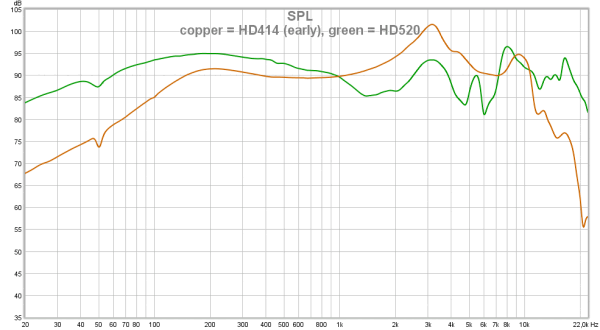
phase response
Below the phase response of the HD 520 (Left, Right)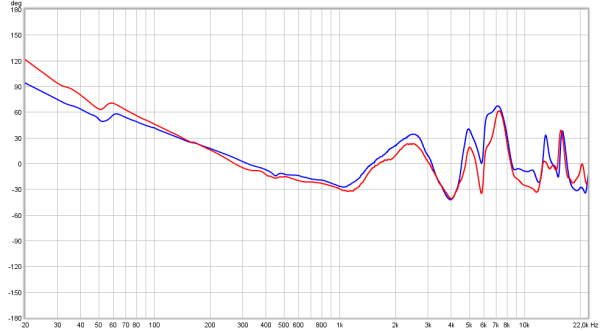 Gentle sloping phase is not audible. Above 3kHz the phase is changing rapidly within a narrow frequency band and is more problematic. Pad-bounce (55Hz) is minimal. Combined with uneven frequency response the rapid (narrow band) phase shifts may also be responsible for the lower quality treble.
Gentle sloping phase is not audible. Above 3kHz the phase is changing rapidly within a narrow frequency band and is more problematic. Pad-bounce (55Hz) is minimal. Combined with uneven frequency response the rapid (narrow band) phase shifts may also be responsible for the lower quality treble.
When I received this headphone the right side had the headphone connector plugged in the wrong way around. When the previous owner used to listen to it this way it sure would have sounded different from other HD520’s. Below the phase response with the connector reversed.
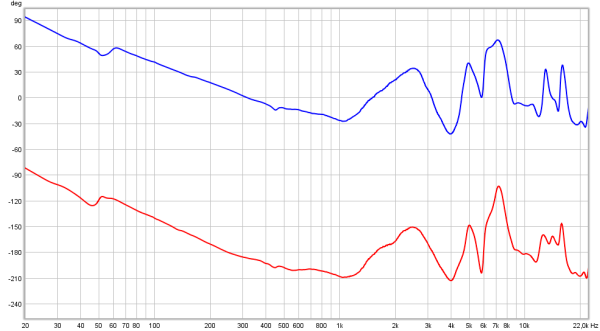
output resistance / damping-factor
As this is a dynamic headphone the frequency response can be amplifier output resistance dependent when certain higher output resistance amplifiers are used.
Instead of showing impedance plots, which are hard to ‘read’ when it comes to assessing the tonal balance change in the real world, the HD 520 is measured via a few different resistance outputs (0.2Ω, 10Ω, 33Ω and 120Ω). On a higher output resistance amplifier the output level will be lower of course due to voltage division. To compensate for this the amplifier is cranked up to the same level (1.7dB for 120Ω at 1kHz in this case). This way the plots are overlaid and it is easier to see how the tonal balance changes.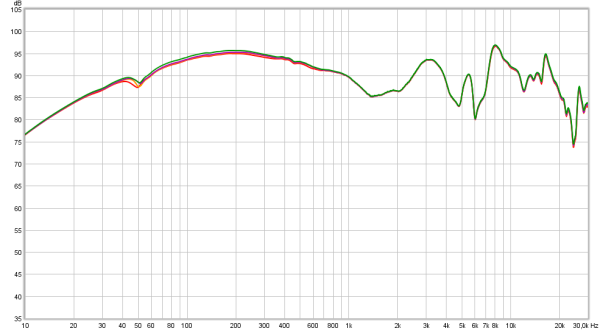
The tonal balance hardly changes when the HD 520 is connected to a higher output resistance amplifier mainly because of the high impedance of the headphone.
seal
Seal can be an issue with closed-back headphones but is usually less of a problem for open headphones. Breaking the seal (improper fit on the head) usually means a loss of (sub)bass. Perfect seal, seal broken with a thick arm pair of glasses and seal broken by thick arm glasses not resting against the skin and finally seal substantially broken by lifting the bottom of the pads a few mm which can occur when not properly seated.

The HD 520 is quite insensitive to a seal breach. People wearing glasses are greeted with the same amount of lows as the ones having a perfect seal.
Below the distortion measurements of the HD 520 (Right channel).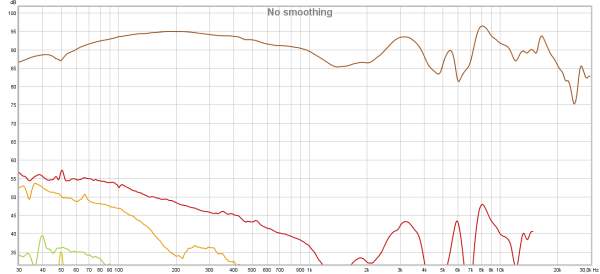 The plot above shows the level differences between the signal (upper trace around 90dB SPL @ 1kHz)) and the harmonics. Most people prefer to see percentages instead of level differences so below the exact same plot except ‘normalized’ to the actual signal and level differences given in percentages.
The plot above shows the level differences between the signal (upper trace around 90dB SPL @ 1kHz)) and the harmonics. Most people prefer to see percentages instead of level differences so below the exact same plot except ‘normalized’ to the actual signal and level differences given in percentages.
Distortion levels in the lowest frequencies are mainly 2nd harmonic above 200Hz distortion drops below 0.5% which is good for a driver of this size.
The actual 2nd harmonic distortion above 1kHz may well be lower than 0.2% . A shortcoming of my measurement rig.
Below the CSD (waterfall) plot of the HD 520. (Left and Right are overlaid)
At 3kHz there is a resonance but as the ear-canal itself also resonates at that frequency that won’t be very audible as. Of course the amplitude peaking is audible, just not the time aspect.
Below the Group Delay plot for the HD 520 (Left, Right)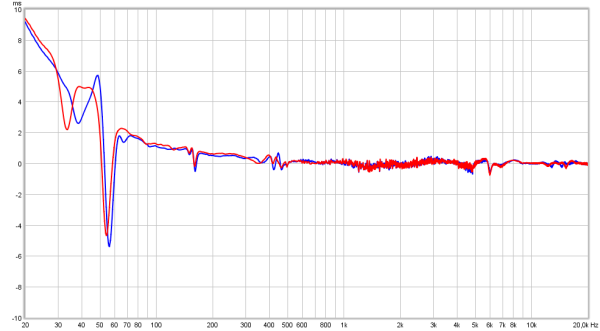
There is some pad bounce at 30Hz and 55Hz, otherwise no surprises here. Some smaller resonances around 180Hz, 400Hz and around 5-6kHz is visible.
A different plot is the spectrum plot. This basically is a CSD (Waterfall) plot but viewed from above where the level differences are colour coded instead of being in the vertical axis. Also the frequency range of the spectrum plot is wider (from 100Hz instead of 500Hz). The time span is also bigger in the spectrum plots and expired time is shown from below to top where in the CSD the time is shown from rear to front.
Below the spectrum plot of the HD 520 (Right channel).
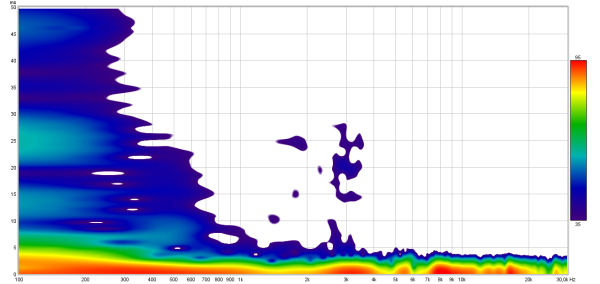 No alarming issues here either. (ignore the little ‘islands’) in the middle frequencies.
No alarming issues here either. (ignore the little ‘islands’) in the middle frequencies.
Step response
Below the step response plot which, when the sound is balanced and well extended should show a rise to around 0dB, (indicating fast driver response) and should be slightly sloping downwards indicating bass extension. (Left, Right) The lack of deep bass extension is visible as the horizontal trace drops after 1ms. The elevated part around 350μs shows the ‘shouty’ character (the hump at 3kHz).
The lack of deep bass extension is visible as the horizontal trace drops after 1ms. The elevated part around 350μs shows the ‘shouty’ character (the hump at 3kHz).
pad replacements
Because the original pads, sadly, are no longer available (they had been for 40 years !) owners will have to be looking for alternatives.
The same is true for the foam discs which will certainly have disintegrated to some black sticky stuff.
Having a few pads lying around for test purposes and having bought a ‘replacement’ pad on Amazon it was time to do some testing.
The first hurdle was to recover the mounting ring. Circular middle part and oval outer part. That mounting ring needs to be removed from the original pads which requires molesting the plastic firm plastic part of the original part itself. Once removed the new pad needs to be mounted and the mounting ‘flap’ of the pads needs to be cut to conform to the ring.
Also the foam disc needs to be replaced. The foam from HD650’s works well here.
Below 4 pads that were measured compared to the original pads.
It was surprising to see the foam inside the original pads still had its original shape and had not decayed.
The thin pleather still was good as well. (see picture on the top of this page).
Below the original pad versus the Amazon replacement pad.
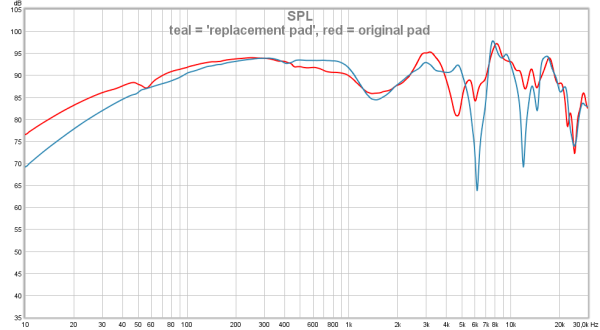
Bass extension is not as good, linearity from 200Hz to 1kHz is better. The 3kHz peak is lower but deeper ‘dips’ in the upper treble and the 8khz peak is still there (sharpness in some recordings).
Below the Brainwavz oval pleather pads compared to the original pads. (flaps need trimming).
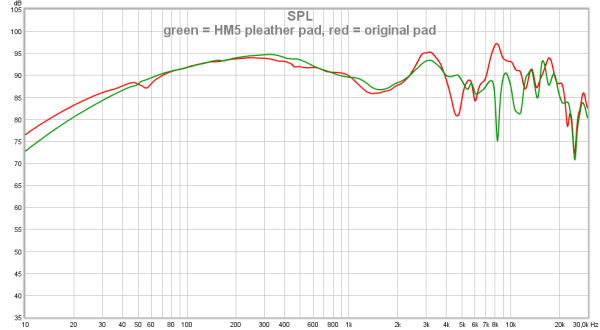 This is more like it. Very similar sound, slightly reduced 3kHz peak and a more even response (averaged) compared to the original pads. A good substitution with good comfort.
This is more like it. Very similar sound, slightly reduced 3kHz peak and a more even response (averaged) compared to the original pads. A good substitution with good comfort.
Below the Brainwavz oval velours pads vs original pads.
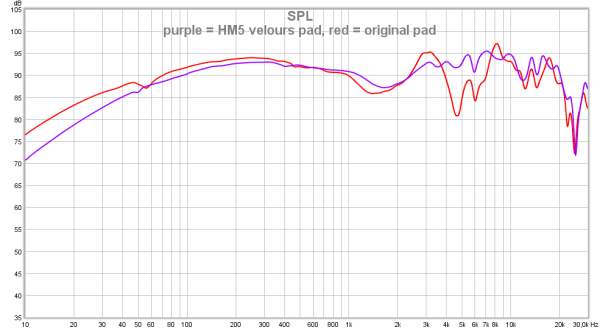 This one (not shown as the traces are overlaid) reduces the efficiency further by about 4dB. Has audible less bass but less colored mids but is a bit brighter sounding but with better treble quality. A tradeoff.
This one (not shown as the traces are overlaid) reduces the efficiency further by about 4dB. Has audible less bass but less colored mids but is a bit brighter sounding but with better treble quality. A tradeoff.
Below the fenestrated Alcantara Shure HPAEC1540 pads vs original pads.
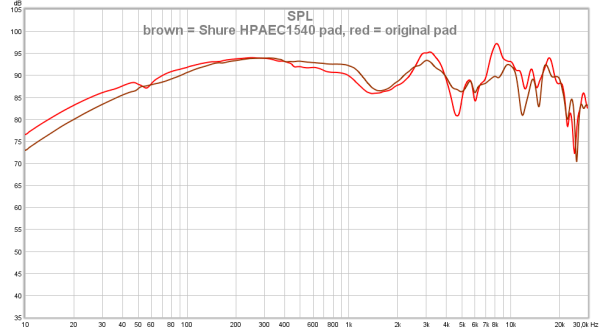 These are very comfortable and have less colored mids and better treble quality but at the expense of having slightly less bass.
These are very comfortable and have less colored mids and better treble quality but at the expense of having slightly less bass.
Conclusion
The original Sennheiser HD520 is an old headphone (1985) with a very high impedance (600Ω) which requires a bit more output voltage than your average phone, tablet, laptop, PC can muster.
You need an amplifier that can supply a higher voltage (very, very little current/power). So an amplifier that can provide at least 100mW in 300Ω is required. Perfect for OTL tube amps for instance.
This isn’t the best in SQ. The HD540 reference is the better one for sure.
I don’t know how much this original HD520 differs from the HD520-II or the HD530(II).
Unless you are a collector that is missing a HD520 in their collection it makes little sense to buy one now… at any price. There are better headphones to choose from when desiring a ‘classic Sennheiser’.
Comfort is quite good though. The sound is dynamic and forward, a bit lean in the bass. Low bass can still be heard but not on the correct level. A bit midrangy/shouty headphone with mediocre mid and treble quality.


I just got some HD 520 off eBay for about $60 USD. Waiting on some replacement pads, found some original Sennheiser ones in the UK. I also haven’t been able to really test them yet as I don’t have a headphone amp and they sound quite thin through my Focusrite audio interface. Going to order a Topping L50 to drive them and maybe get the E50 DAC to go with it.
They are quite insensitive and are rolled-off in the bass. An amp will at least make them go louder and thus relatively have more perceived bass as well.